Introduction
Climate and environmental challenges facing the world have become increasingly pressing, urgent measures need to be taken to combat the environmental degradation and climate change. To meet these challenges, the European Commission is committed to making a significant contribution to mediating the issues by launching a new growth strategy, the European Green Deal. The implementation of this strategy marks the change of the paradigm of economic growth based on consumption, thus, the aim is to move to a sustainable economic growth, based on the efficient use of natural resources. The main objectives of the European Green Deal are: i) the elimination of greenhouse gases by 2050; ii) streamlining the use of resources and decoupling them from economic growth (eliminating the dependence of economic growth on the use of resources); iii) as well as the commitment to “leave no one behind”, an objective that involves eliminating inequalities and creating a favorable framework for all EU citizens.
A fair transition from which everyone can benefit requires a well-developed strategy as well as a consistent budget for the necessary investments. Thus, the implementation budget is a significant one of about 1000 billion Euros, for the next 10 years. These transition funds depend on the authorities’ ability to develop projects and how they will manage their implementation.
At its meeting on 17th-21st July 2020, the European Council agreed to allocate € 1 824.3 billion to the Multiannual Financial Framework and the Next Generation EU recovery instrument. Of this amount, 30% will go to climate change projects, in particular, with the goal of eliminating greenhouse gases by 2050 (EU climate target for 2030) and the Paris Agreement.
The most important objective of the Green Deal refers to the decarbonization of the energy sector because over than 75% of greenhouse gas emissions are produced by the use of energy in economic sectors. This is a matter of concern among member states, who point out that the lack of alternatives for carbon-intensive sectors or a too abrupt transition will lead to job losses and regional inequalities.
The effects of climate change are being felt unequally in the world.
The areas in which we live influence the way we are affected by the environmental degradation. Environmental degradation generally affects more disadvantaged and vulnerable people and households living in areas prone to drastic climate changes or with limited access to environmental qualities (green spaces, fresh air, fresh food), thus contributing to increasing poverty and inequality.
Inequality has been a constant concern in the climate change debate. From the perspective of the responsibility for tackling climate change, there is inequity between countries because they are countries with a low carbon footprint, but from which significant indirect contributions can be sought that could deepen existing inequalities. Development gaps between countries or regions risk placing a greater burden on certain categories of vulnerable citizens who cannot easily find alternatives or adapt to new changes due to geographical factors or specific robust skills, and difficulties in professional reconversion.
The pandemic created by COVID-19 caused both health and economic and social crisis. The lockdown has led to job losses and rising inequalities. In this situation, some opinions suggest that measures on climate change could be postponed and attention should be focused on measures for the economic recovery. At the EU level, it has been decided that this is the right time to establish a Recovery Plan that also includes Green Deal’s objectives. Thus, this plan is pursued to invest in an ecological future that not only ensures an inclusive recovery, new jobs creation and new opportunities, but also supports the sustainable development.
What is clear now for the European Union is that the European Green Deal must not be a choice between development, recovery and combating climate change, but this pact must connect the improvement of the economic and social situation with actions to fight against environmental degradation.
Literature Review
The concept of climate change is not a new one, but it has recently become more widespread in the context of the European Green Deal. The risks to which the entire globe is exposed due to these changes are both on the health of the environment and the population, and on the economy. Thus, extreme climate changes and calamities affect the economy on the one hand, by degrading crops and reducing trade, as well as the health and well-being of the population by reducing the quality of life. The excessive use of natural resources is not only a major concern for Europe’s sustainability, but also for the quality of life for the future generations.
Not surprisingly, in terms of climate change, the most disadvantaged are low-income and vulnerable people with no or limited recovery capacity. There are numerous studies that have analyzed the negative effects of climate change on the economy and society. Climate change has been analyzed as a major concern for poverty reduction (World Bank, 2002; Skoufias, 2012). Also inequality reduction was affected by climate changes, it has been analyzed and demonstrated that the link between climate change and inequality forms a vicious circle, so that existing economic and social inequalities contribute to the unequal distribution of environmental degradation, thus generating greater inequalities. (WESS, 2016; Islam & Winkel, 2017).
Other studies such as (The Intergovernmental Panel on Climate Change, 2014) conclude that climate change “exacerbates inequalities”. The explanation is that in disadvantaged regions in terms of the geographical location, as well as infrastructure, there is a high risk that a burden of climate change will further disadvantage people living in those regions. The study also shows that people in countries facing significant social inequalities are more affected by climate change.
With regard to the Green Deal objectives, there are concerns that some countries cannot easily cope with the transition period and that complementary policies are needed to deal not only with reducing the effects on the environment but also on the economy and society. “We must understand that ecological and social progress go hand in hand. We cannot end poverty and build a fairer society by letting the ecological crisis destroy our planet. However, we also cannot end the ecological crisis while high levels of poverty and inequality persist.” (Sassoli, 2020)
According to some authors (Pianta et. al, 2020), the European Green Deal will generate an expansionary fiscal policy that will end the period of stagnation in Europe due to fiscal constraints. This new fiscal policy is needed to increase the demand and investments needed for sustainable production systems. If this does not happen and only giving up old polluting production technologies without increasing investments, along with the current spending on environmental goods and services, there will be a reduction in jobs and incomes.
Green deal and the other EU’s policies
The adoption of the European Green Deal is the European Union’s responsible response to climate change that affects all of us and, implicitly, our future. The consequences of climate change affect important issues such as public health, quality of life, and even life expectancy. Article 3 of the Lisbon Treaty states that “the Union shall establish an internal market. It works for the sustainable development of Europe, based on balanced economic growth and price stability, a highly competitive social market economy, which aims for full employment and social progress, as well as a high level of protection and improvement of the quality of the environment.” (Treaty of Lisbon) and that “In its relations with the rest of the international community, the Union affirms and promotes its values and interests and contributes to the protection of its citizens. It contributes to peace, security, the sustainable development of the planet, solidarity and mutual respect between people, free and fair trade, the eradication of poverty and the protection of human rights, and in particular the rights of the child, and the strict observance and development of international law, including compliance with the principles of the Charter of the United Nations.” (Treaty of Lisbon).
Thus, the sustainable development of Europe as well as the sustainable development of the planet includes three main components, the economic, the social and the environmental. The European Union is proposing an ambitious environmental policy plan and intends to place the Community in a position of global leadership in reducing greenhouse gas emissions. To achieve these results, the budget for the European Green Plan is significant, amounting to around € 1 trillion over the next 10 years. Negotiations on the EU’s long-term budget for 2021-2027 have shown the political support for this plan due to large sums allocated.
The European Green Deal is directly related to the Cohesion Policy, in which investments in the regional development will focus on two objectives. Specifically, the European Commission wants 65% -85% of the European Regional Development Fund and Cohesion Fund funds to be focused on developing a smarter Europe and developing a greener Europe. It is worth pointing out that the European Green Deal promotes the objective of the cohesion policy, reducing the disparities between different regions and more disadvantaged regions, through the Mechanism for a Fair Transition. Thus, we want to move to a green economy but without this process creating gaps between regions and generating inequalities in societies. Many regions that have industries that are based on processes with a high carbon dioxide emission factor that generate greenhouse gas emissions or whose workers are part of these fields could suffer heavy losses if they are not taken into account in defining measures. One initiative is the Fair Transition Mechanism, which will pay attention to the regions facing the greatest challenges and which will have 3 indicators on which to allocate funds: the extent of the challenge posed by the transition for regions with a carbon dioxide emission factor; high carbon and greenhouse gas emissions; the social challenges posed, on the one hand, by the potential loss of jobs related to carbon dioxide emissions , such as in the sector of oil shale mining, coal and lignite mining and peat production and, on the other hand, by the need for further retraining of workers to be able to find new jobs; as well as the level of economic development and investment capacity of the Member States. The identified regions will benefit from around € 30-50 billion between 2021 and 2027, for every € 1 invested through the Fair Transition Mechanism, Fund Member States will contribute a minimum of € 1.5 and a maximum of € 3 from the European Development Fund and the European Social Fund Plus, to which the national co-financing of the cohesion policy will be added.
Green Deal and inequalities
Climate change is negatively affecting the lives of each of us and for some, it makes it even more difficult. The challenges that climate change offers us are as important as the problem of inequalities, both of which are manifested globally, and there is even a relationship between them. This implies the need for ambitious policies, both at the EU and global level, because only through the active and serious involvement of both policy makers and citizens, will we be able to develop a sustainable future. The European Green Deal is the EU’s response to climate challenges, and involves tracing the current economy and society on a more sustainable and inclusive path.
One of the objectives of the European Green Deal is to reduce greenhouse gas emissions by at least 55% by 2030 compared to their level in 1990, making Europe the first neutral continent of greenhouse gas emissions in 2050. At the level of the European Union, Greenhouse gas emissions have been on a downward trend since 1990. Peak values are marked by either extreme climatic phenomena (1996 – very low winter temperatures that led to increased heat demand), or the adverse effects of the financial crisis (2009) that affected the plants, generating strong greenhouse gas emissions. In 2018, the amount of greenhouse gas emissions has decreased considerably compared to 1990 and is constantly decreasing.
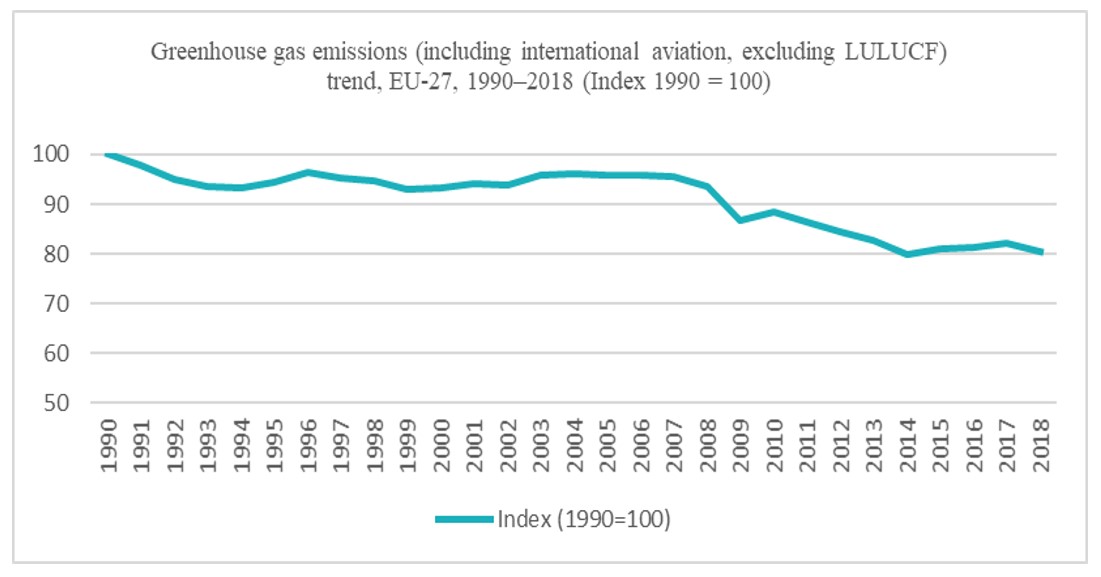
Fig. 1: Greenhouse gas emissions (including international aviation, excluding LULUCF)
Source: Eurostat
Among the EU countries, the highest reductions in greenhouse gas emissions from 1990 to 2018 were registered in Lithuania (-57.36%), Latvia (54.05%) and Romania (53.16%), and the countries with the highest levels were Cyprus (53.81%), Spain (19.74%) and Portugal (18.90%).
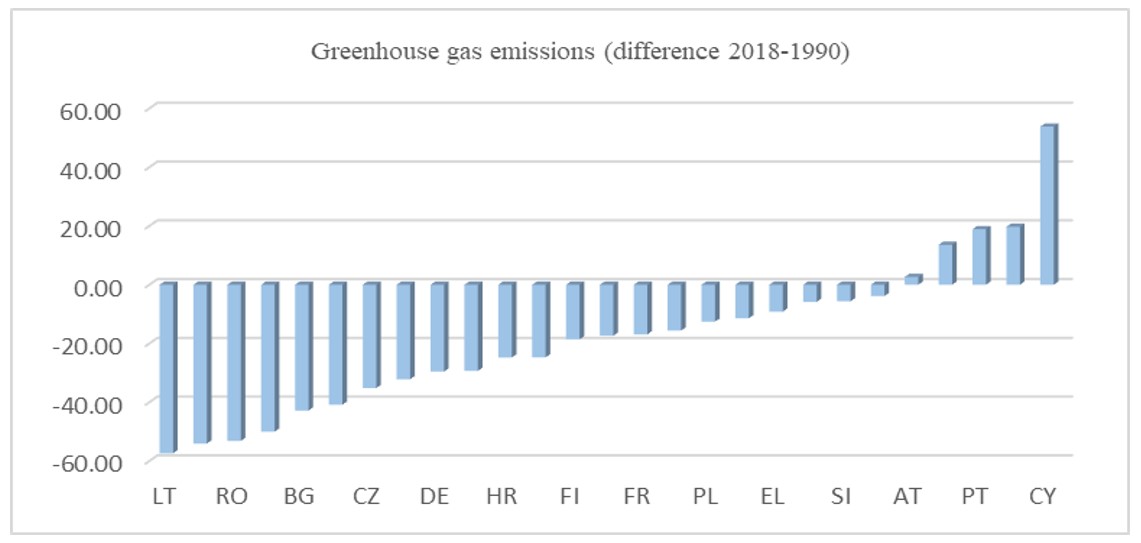
Fig. 2: Greenhouse gas emissions (difference 2018-1990)
Source: Eurostat
The relationship between inequalities and greenhouse gas emissions has been the subject of numerous specialized studies. Environment Kuznets Curve (EKC) hypothesis describes an inverted U-shaped relationship between economic development and environmental degradation. He asserts that the environmental quality deteriorates as per capita income increases at the initial stage of development but improves after a certain threshold of per capita income (Magnani, 2000). Most studies are based on the relationship between income inequality and environmental quality.
Another theory about the relationship between inequalities and the environment concludes that there is a difference between social classes regarding the environmental pollution (Boyce, 2007). The rich class pollutes the environment more because they consume more goods and they own polluting firms. Under Boyce’s political economy model, the political class can avoid environmental laws that would bring them additional costs by influencing politicians. He demonstrates that the wealthy class can use their economic and political bargaining power to undermine policy makers’ efforts towards environmental protection endeavors. Scruggs (1998) launches a hypothesis that demonstrates that environment is a normal good, an increase in per capita income could be associated with the same level of preference for environmental degradation. But, if we define environment as a superior good, an increase in income will determine a preference for a cleaner environment, because the wealthy prefer a clean environment, consequently, they will promote strict measures.
Another area of action of the European Green Deal is agriculture and nature. Climate change is affecting agriculture, as there are areas where, due to rising temperatures, the soil is desertifying, or we have situations where crops have been destroyed by the increasingly present extreme phenomena. The most affected are the small producers for whom the income from agriculture is the only revenue in the family, many of them also having credits for the necessary equipment or materials. There were 10.5 million farms in the EU in 2016; the majority of these classified as family farms (95.2). According to Eurostat, in 2016, one third of the EU farms are developed in Romania, followed by Poland, Italy and Spain. Although about 65% are farms with an area of less than 5 hectares, about 7% of farms with an area of 50 hectares or more have cultivated 68% of the EU’s agricultural area. Many small farms are characterised by the fact that farm holders may struggle to make a living. A characteristic of very small farms is that they are often subsistent households. These small farms can play an important role in reducing the risk of rural poverty, providing additional income and food. Thus, climate change tends to aggravate income inequalities by affecting crops, which leave farmers with no income and only expenses. Romania, the country that, in 2016, had the most farms in the EU, was hit in 2020 by one of the strongest droughts that destroyed most of the cereal crops. This will lead to a decrease in the supply and an increase in the prices amid the high demand, which will worsen the financial situation of vulnerable low-income people.
Another problem facing the European agricultural sector is the widespread use of pesticides that affect human health. Countries such as France and Spain have sales of more than 35 million kilograms of pesticides per year, according to Eurostat. The use of pesticides aims to keep the plant healthy, but at the same time produces negative effects, they infiltrate in the soil and water. In the long run, this may mean destroying soil biodiversity and making it impossible to use it in the future. At the EU level, the number of organic farms is very low, as can be seen in the graph below, with an average of 8%. Austria, Sweden and Estonia have the highest results.
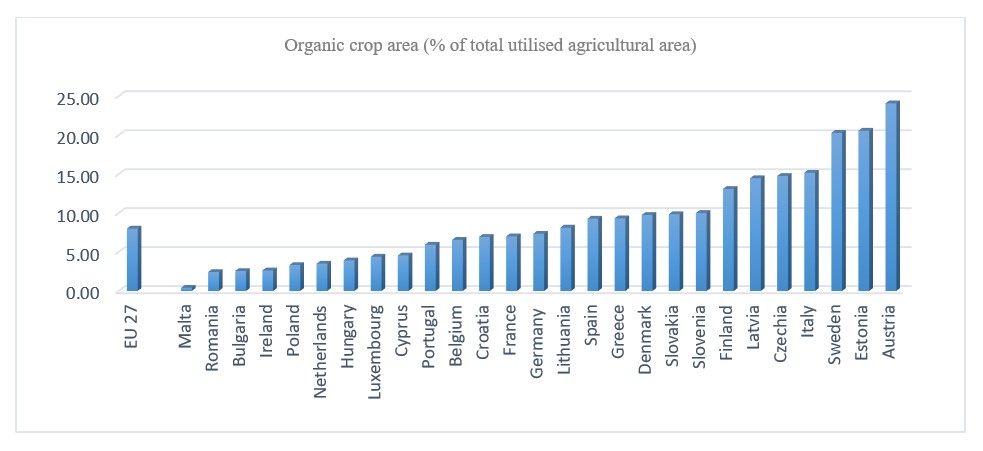
Fig. 3: Organic crops area (% of total utilised agricultural area)
Source: Eurostat
The objectives proposed by the European Green Pact are to reduce the pesticides used in agriculture by 50% by 2030, to increase the area of organic farms and to invest in research and development in agriculture to develop sustainable agriculture. The European Commission proposes that 40% of the budget allocated to the common agricultural policy should contribute to combating climate change, and 30% of the Fisheries and Maritime Fund should contribute to climate goals.
Mobilizing the industrial sector for a green and circular economy is another objective of the European Green Deal. The European industry continues to be highly dependent on newly extracted, marketed materials, which then end up in landfills. According to the European Commission, in 2017, the world extraction of materials had tripled compared to 1970, and continues to have an upward trend. As can be seen in the figure below, the generation of waste is very high, which indicates a waste of resources. Romania, Sweden and Bulgaria have the highest amounts of waste. The storage of this waste, sometimes illegal, causes some areas where there are landfills to suffer numerous losses. From soil and river contamination to the release of pollutants into the atmosphere, landfills cause consequences that intensify regional inequalities.
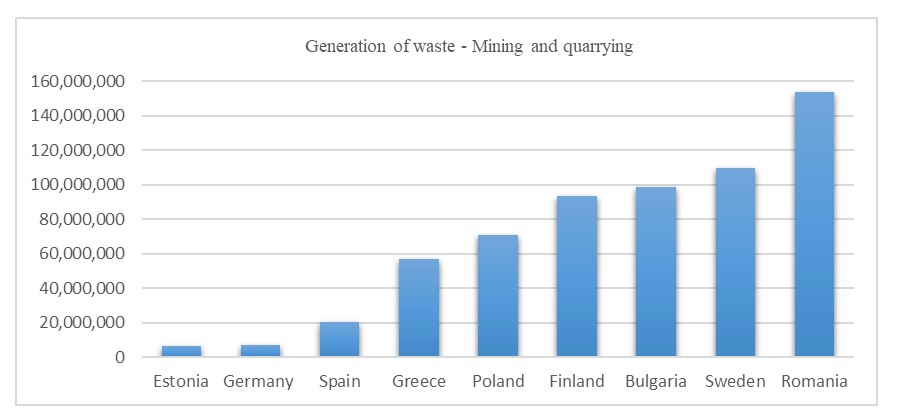
Fig. 4: Generation of waste- Mining and quarrying
Source: Eurostat
The solution would be to recycle and reuse materials in production processes. At this point, the situation at the EU level on recycling can be seen in the figure below. It can be seen that countries that are at the top of the ranking at the level of waste, such as Romania or Bulgaria are at the bottom of the ranking in terms of waste recycling. The European Green Deal aims to stimulate a green economy, based on renewable resources and the reuse of materials and products. Consumers will also be encouraged to recycle more and give up buying single-use or limited-use products.
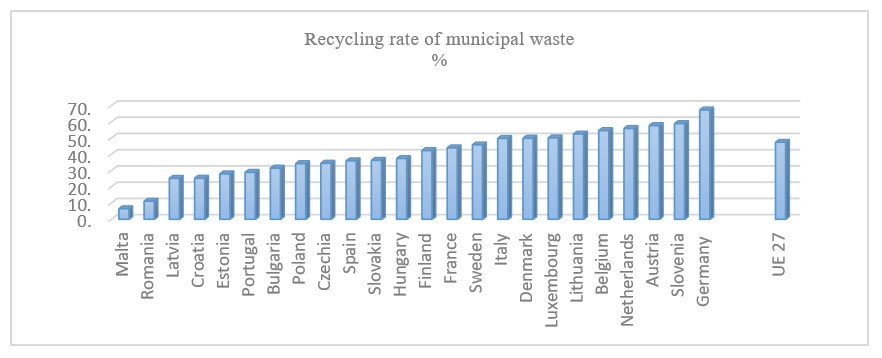
Fig. 5: Recycling rate of municipal waste
Source: Eurostat
Last but not least, the objectives and areas of action of the European Green Deal are designed to develop a sustainable growth model conducive to inclusion. The transition can affect many people and regions, leading to growing inequalities. Also, not all member states will have the same starting point; some will have to implement many or even more drastic measures, while for others, who have adopted environmentally friendly measures for years, the transition will be smoother. It is important that people always be at the forefront of taking actions, as well as managing the process to take difficulties into account and prevent them. The challenges of climate change can be turned into a unique opportunity to transform the economy into a more environmentally friendly one, create new and better paid jobs, and improve the health of citizens and their daily lives.
EGD – The Long-Term Recovery Strategy
Nowadays, countries around the world are facing an unprecedented situation with a health pandemic turning into an economic and social crisis. The decline in the economic activity caused by lockdown has generated imbalances in the labor market (by reducing labor demand and increasing unemployment); also the social situation is warrying (high levels of inequalities and poverty).
Due to the pandemic caused by the coronavirus, the implementation of Green Deal priorities has been postponed to the detriment of measures to stop the pandemic. But the climate emergency has been identified as a priority just like the measures to recover and stop the pandemic. Both involve market failures, negative externalities, and the need for international cooperation. Now, more than ever, an urgent action is needed for both the pandemic and the climate crisis.
Thus, by implementing the first package of measures to combat the effects of the pandemic, it was decided to place the growth strategy at the center of the recovery actions, changing its direction of action from a growth strategy to a recovery strategy, correlating recovery measures with objectives transition to a green economy and digitization.
The European authorities urge countries not to lose sight of climate goals but to take them into account in formulating the response to post-covid recovery, as these measures will have the potential to generate new jobs while improving environmental conditions.
At the July summit, the European Community demonstrated in its decisions that climate action is an important part of the Recovery Package. About 30% of the budget was allocated to climate and environmental measures, the largest budget allocation that the Community has ever distributed to green targets. The European Commission’s recovery plan aims to mobilize €1.85 trillion through a renewed EU 2021-27 budget of €1.1 trillion and a Next Generation EU fund of €750 billion.
It is important that the Recovery Plan not to be focused only on increasing consumer spending but also to provide investments that stimulate the economy in the long run (create job opportunities and at the same time protect the environment through a sustainable development). The European Union can become a world leader in the transition to a green future if it seizes the opportunity to address both social and economic inequalities and climate change with a plan of concrete actions. The European Green Deal is defined on the basis of the Recovery Plan, and identifies the flagship areas that have the potential to contribute to the economic recovery and accelerate the transition for key sectors to achieve the European goal of climate neutrality.
Different green sectors can be employment opportunities for young people affected by unemployment and a retraining opportunity for those who have lost their jobs due to the pandemic. The issue of youth unemployment remains a topical issue in the EU, according to Eurostat it was 14.7% in 2020-Q2. Postponing the initiation of measures for youth integration into the labor market would lead to an increase of social and economic inequalities. Therefore, public investment in the green economy is an opportunity for young people with higher education, for example in the renewable energy industry, but in the same time, it can be an opportunity of organic farming for those with secondary education from disadvantaged areas.
We Mean Business Coalition (2020) conducted a study in which they analyzed two possible scenarios for an economic recovery, one that involves stimulating household consumption and the second that involves increasing the economic activity while reducing CO2 emissions. The results of the analysis indicate that The Green Recovery Plan could save 2 million jobs in the EU in the more immediate recovery period and generates longer-term employment gains. Spain has so far been one of the countries worst hit by Covid-19, and the economic recovery could take several years. The model results show that a green recovery could save 400,000 jobs in the next three years, with longer-term labor market benefits.
Policy Recommendations
The implementation of the Green Deal has both beneficial effects for the environment and the population and challenges that are felt differently for European Union countries, so the authors of this paper propose a series of policy recommendations in order to achieve the most efficient objectives of this project, without creating new problems and without aggravating the existing ones.
- Profound changes in technologies and production process. There is a need to replace old and polluting production technologies with new and efficient ones, improved in terms of resources used. It is also necessary to transform the capacities and abilities of the population in order to be able to use and develop new production technologies.
- Interconnection of environmental and industrial policies. A common approach to the environmental and industrial policy is closely linked to the fiscal, monetary, competition, trade, technology and labor and wage policies that need to be considered.
- Ensuring social equity. The participation of all citizens in the transition activities and the equal distribution of benefits are essential for the implementation of the Green Deal.
- Identifying alternative solutions for the specificity of each region affected by the transition. It is necessary to identify alternative solutions taking into account the industry specific to each region. Identifying a single alternative solution without taking this aspect into account can increase the burden for certain groups of people.
- Collective practices. The government must ensure that all citizens are involved in combating climate change actions. It also aims to create a mix of appropriate policies to ensure that the achievement of ambitious climate change goals will not intensify economic and social problems but mediate them.
- Public and private investments. It is recommended to boost the demand for private and public investments, current public spending on environmental goods and services, and exports and consumption. On the contrary, eliminating old polluting production would simply lead to a reduction in production, jobs and income, destroying the consensus for the Green Deal.
Concluding Remarks
In the current pandemic context, the climate change policy can be seen as an opportunity for an economic recovery, but the unequal effects on societies as well as regions must be taken into account. Otherwise, the Green Deal will not be able to meet the inclusion target. The effects of investing in green goals will not only lead to the economic recovery and job creation, but will also build a green future with more opportunities due to the sustainable development. Measures to combat climate change can no longer be postponed and are necessary to be included in each Member State’s recovery plans. In this way, the authors of this paper show their solidarity with those who have been affected by the pandemic, but they also show their solidarity with future generations by building a sustainable future.
In terms of social inequalities, they pose risks both in the context of climate change and in the attempt to combat climate change. Thus, it is absolutely necessary that inequalities be at the heart of economic recovery policies as well as at the heart of Green Deal policies.
Regarding gas emissions, the evolution at the EU level has not been uniform, with some countries managing to reduce gas emissions while others have increased them. This issue leads to climate change that affects agriculture and creates social and economic inequalities. As presented above, most farms in Europe are classified as family farms. Thus, the present extreme phenomena destroy cultures and leave many families without income. Another major problem is the excess use of pesticides and the low number of organic crops. At the EU level, only 8% of the total agricultural area used is organic. In addition, the European Green Deal also aims to increase recycling. In the EU, countries such as Romania and Bulgaria have the highest levels of waste generation. In terms of municipal waste recycling, Slovenia and Germany are the countries that recycle the most, while the EU average is around 45%.
Investments, both public and private, are the key to a successful transition for EU countries, but the management of the Green Deal depends on each country’s absorption capacities and their ability to develop feasible projects that can be financed through the European Commission’s instruments.
Acknowledgment
This paper was co-financed by The Bucharest University of Economic Studies during the PhD program.
(adsbygoogle = window.adsbygoogle || []).push({});
References
- Anbarci, N., Escaleras, M., Register, C. (2005), ‘Earthquake fatalities: the interaction of nature and political economy’ Journal of Public Economics, 89, 1907–1933.
- Barbier, Edward B. (2010), ‘Poverty, Development and Environment,’. Environment and Development Economics, 15( 6), 635-660.
- Boyce, James K. (1994), ’ Inequality as a Cause of Environmental Degradation,’ Ecological Economics, 11, 169-178.
- Boyce, James (2007), ‘Is inequality bad for the environment?,’Political Economy Research Institute, [online] available: https://scholarworks.umass.edu/peri_workingpapers/121/
- European Commissions (2020), ‘Communication: A new Circular Economy Action Plan for a Cleaner and More Competitive Europe’, [online] available: https://ec.europa.eu/info/strategy/priorities-2019-2024/european-green-deal_ro
- European Commission (2019), ‘Communication from the Commission -The European Green Deal’ , [online] available: https://eur-lex.europa.eu/legal-content/EN/TXT/HTML/?uri=CELEX:52019DC0640&from=EN
- Eurostat, Statistical Books (2018), ’Agriculture, forestry and fishery statistics, ‘[online] available: https://ec.europa.eu/eurostat/web/products-statistical-books/-/KS-FK-18-001
- Eurostat, Statistics Explained (2020), ‘Greenhouse gas emission statistics – emission inventories’ , [online] available: https://ec.europa.eu/eurostat/statistics-explained/pdfscache/1180.pdf
- Islam, S. and Winkel, J. (2017). ‘Climate change and social inequality,’ DESA Working Paper No. 152 ST/ESA/2017/DWP/152
- Magnani, E. (2000), ‛ The Environmental Kuznets Curve, environmental protection policy and income distribution’. Ecological Economics, 32(3)
- Pianta, M., Lucchese, M., Nascia, L. (2020), ‘The space for a novel industrial policy in Europe’.Industrial and Corporate Change, 29(3), 779-795
- Pianta M, Lucchese M.(2020), ‘ Rethinking the European Green Deal: An Industrial Policy for a Just Transition in Europe’, Review of Radical Political Economics, [online] available: https://journals.sagepub.com/doi/full/10.1177/0486613420938207?casa_token=69fjD9_fJEAAAAAA%3AYieHE-g5fIS1MS73V15dr7Iv2JMeUetRqH_mTF5vJDItWSUFh2P9ADEtXFWVZ3SMKGUClumiFoFNIA
- Scruggs, L. A. (1998), ’ Political and economic inequality and the environment’, Ecologicaleconomics, 26(3)
- Skoufias, Emmanuel, ed. (2012). The Poverty and Welfare Impacts of Climate Change: Quantifying the Effects, Identifying the Adaptation Strategies. Washington, D.C.: World Bank
- The Intergovernmental Panel on Climate Change (2014), ’ Climate Change 2014: Impacts, Adaptation and Vulnerability’, [online] available: https://www.ipcc.ch/report/ar5/wg2/
- United Nation (2016), ’World Economic and Social Survey 2016: Climate Change Resilience: An Opportunity for Reducing Inequalities’, [online] available: https://www.un.org/development/desa/dpad/publication/world-economic-and-social-survey-2016-climate-change-resilience-an-opportunity-for-reducing-inequalities/
- We Mean Business Coalition. (2020). Assessment of Green Recovery Plans after Covid-19. Retrieved from https://www.wemeanbusinesscoalition.org/wp-content/uploads/2020/10/Green-Recovery-Assessment.pdf
- World Bank (2002), ’ Poverty and Climate Change: Reducing the Vulnerability of the Poor through Adaptation’, [online] available: https://www.worldbank.org/en/home
- World Bank (2008), ‘Global Monitoring Report 2008: MDGs and the Environment: Agenda for Inclusive and Sustainable Development’ , [online] available: https://openknowledge.worldbank.org/handle/10986/6518








